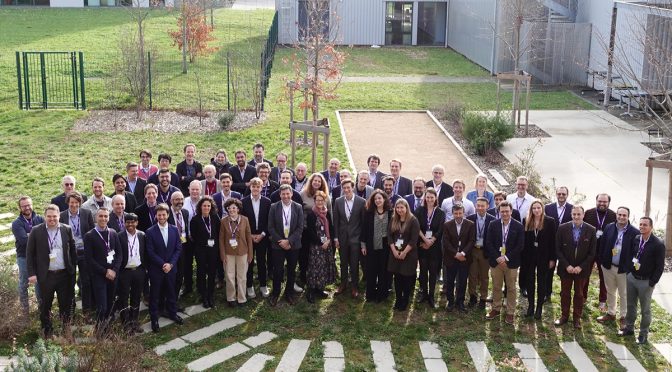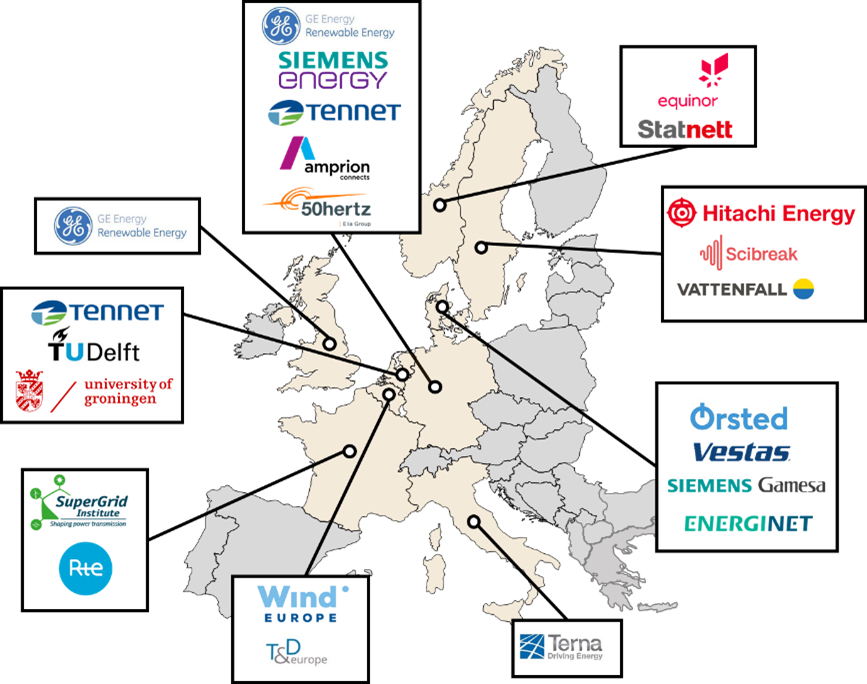Europe is pathing the way for interconnected hybrid offshore wind farms. On this way offshore electricity transmission is a key challenge. The most efficient way of transporting electricity from offshore wind farms is via multi-terminal high voltage direct current (HVDC) grids. The EU-funded project InterOPERA will define future interoperability standards for these grids. The project was officially launched this week in Lyon, France.
Europe wants to build around 450 GW of offshore wind by 2050. The EU alone wants to have 300 GW by then. So-called hybrid offshore wind farms will play an increasingly important role in delivering this target. In the future offshore wind farms will not only transmit electricity directly to shore. They will also serve as interconnectors between countries and transmit electricity between different wind farms.
WindEurope estimates that up to a third of all offshore wind capacity could be hybrid offshore wind farms by 2050. Most of this capacity will be in the North Sea and will require international collaboration between European countries.
Europe so far has one hybrid offshore wind farm: Kriegers Flak, connecting Denmark and Germany. Cooperations have been announced for hybrid offshore wind projects connecting the Netherlands and the UK; Belgium and the UK; Denmark and Germany; Denmark and Belgium; Estonia and Lithuania.
Three of these projects will be energy islands, gathering the electricity generated by surrounding offshore wind farms and distributing further. Energy islands could also serve as locations for electricity storage or the production of renewable hydrogen.
The Belgian ‘Princess Elisabeth Island’ in the North Sea, will bundle up to 3.5 GW of offshore wind capacity and could have interconnectors with the UK and Denmark. Denmark has plans for two energy islands, an artificial island in the North Sea and another one on the Baltic Sea Island Bornholm. The North Sea energy island could be expanded to up to 10 GW. The Bornholm Island will host 2-3 GW of offshore wind capacity and will be connected to Denmark and Germany.
Towards interoperable HVDC systems
Electricity transmission will play a key role in all of these plans. The most efficient way of transporting electricity from offshore wind farms is via multi-terminal high voltage direct current (HVDC) grids. These HVDC systems combine benefits in a cost-effective way. They make the integration of renewables into the electricity system more effective. And they increase market security and resilience.
Ensuring that HVDC systems, HVDC transmission systems or HVDC components from different suppliers can work together – making them “interoperable”- is a top priority to accelerate Europe’s energy transition.
The InterOPERA project
The project “Enabling interoperability of multi-vendor HVDC grids” (InterOPERA), funded by the EU programme for research and innovation, unites more than 20 European partners. WindEurope will lead the project communication and the dissemination of results. WindEurope can build on the work of the ongoing Ready4DC project which is bringing together key stakeholders and laying down the basis for the real time demonstration if multi-vendor HVDC grids.
InterOPERA Project Partners: Amprion, Delft University of Technology, Energinet, Equinor, GE Renewable Energy, Hitachi Energy, Ørsted, RTE Réseau de Transport d’Electricité, SCiBreak, Siemens Energy, Siemens Gamesa, Statnett, SuperGrid Institute (coordinator), TenneT, Terna, T&D Europe, University of Groningen, Vattenfall, Vestas, WindEurope, 50Hertz.
InterOPERA brings together eight TSOs, three offshore wind developers, four HVDC equipment manufacturers, two wind turbine manufacturers, two sector associations, two universities under the coordination of a research and innovation institute.
The project was officially launched on 17-19 January 2023 with a kick-off meeting in Lyon, France. The European Union is co-funding the project with €50mn, another €19mn are provided by the project partners.
InterOPERA’s main objective is to make future HVDC systems mutually compatible and interoperable by design, and to improve the grid forming capabilities of offshore and onshore converters. Future HVDC systems will be modular. Thanks to common functional specifications and standard interfaces, modules based on different technologies and modules supplied by different manufacturers will be able to interact seamlessly and operate together.
The project is not only about developing technical standards but also about agreeing on the procurement, commercial, legal and regulatory frameworks that will facilitate the tendering, building and operation of full-scale HVDC multi-terminal, multi-vendor, multi-purpose real-life applications anticipated by 2030.
Eric Lecomte, Policy Officer at the European Commission, says: “The large-scale development of offshore renewable energy will be essential to reach our European Union climate and energy targets and to reduce our dependence on energy imports. The interoperable HVDC technologies to be demonstrated by the InterOPERA project will be a key enabler for the meshed connection of those offshore wind farms to the European power grid.”
Sebastien Silvant, InterOPERA Project Coordinator, SuperGrid Institute, says: “InterOPERA’s ultimate aim is to deliver solutions for all HVDC projects stakeholders, that are directly exploitable to tender, build and operate the first multi-vendor HVDC grid systems in Europe.”



